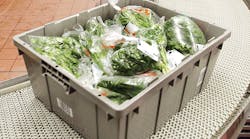Fresh and refrigerated foods continue to gain in popularity as consumers demand healthier foods and shun preservatives. One need only visit a local supermarket, peruse restaurant menus or count the number of nearby farmer’s markets to know this is true, but statistics also support the claim.
A recent article in Food Technology cites Technomic and MSI studies that reveal "nearly nine in 10 adults (87%) feel that fresh foods are healthier, and 80% believe they are tastier." The studies also reveal "that 78% of consumers are making a strong effort to eat more fresh versus processed foods." Witness the selection of freshly prepared and ready-to-cook meals at supermarkets. The article also cites an FMI report that 57% of shoppers are buying fresh ready-to-eat items like rotisserie chickens, sandwiches and sushi often or sometimes, and 44% are buying fresh heat-and-serve foods like pizza and soup.
Providing more fresh ingredients and meal offerings can help consumer brands and the stores selling their products differentiate themselves, particularly in categories that traditionally have not been associated with fresh (i.e., packaged pasta meals now featuring fresher flavors and real cheese), and drive sales. Fresh also carries risk, including food safety concerns and potential for interruptions and breaks in supply, lost sales and disappointed customers.
The Unique Challenges of Fresh Supply Chains
Managing an efficient supply chain is important regardless of the product being sourced and distributed, but especially so when fresh ingredients and foods are involved. Fresh usually means shorter shelf lives, faster turns and lower inventory levels. A fruit with a shelf life of 21 days from the time of harvest to consumption, for instance, typically must be washed, packed and shipped to warehouses and/or distribution centers before making its way to stores and restaurants. Then, quick turnover is important to avoid obsolescence. Compare this to a more shelf-stable product like packaged cereal or peanut butter.
With fresh foods, there also are more potential impacts to supply and the effects are stronger. Weather plays a role and can result in low or no crop yield. Potato farmers reap one harvest per year so a cold snap or extended drought can significantly affect output. Supplier issues, including regulatory violations or equipment failures, and transportation challenges (i.e., lack of capacity, labor disputes, port closures, etc.) also can affect the fresh supply chain and make it difficult to accurately predict supply or make adjustments quickly in light of unforeseen events and fluctuations in consumer demand. The latter is especially volatile because, while fresh remains a growing trend, the "it" food today (i.e., kale, coconut milk, "fill in the blank") may be replaced by another tomorrow.
Other factors affected by fresh include packaging, shipping and storage. Berries and tomatoes, for instance, require clamshell packages to contain and protect them during transit and while on display in stores. There are temperature, storage and shelf life considerations as well. Fresh meats and seafood may be packed on ice and transported to restaurants and food retailers via expedited shipping methods. There are additional costs for transporting goods in temperature-controlled containers. Warehouses and distribution centers must be equipped to handle fresh foods with sufficient cold cases and be agile enough to move product quickly.
The Reality of Going Fresh
In addition to fresher foods, consumers increasingly are seeking foods with more natural ingredients. According to FMI, in 2014, 32% of shoppers surveyed sought products without chemical additives.
Responding to consumer demand, food manufacturers may opt to replace artificial colors in their foods with dyes made from naturally-occurring spices and seeds. Or, they may choose to swap chemical preservatives with more natural alternatives such as rosemary, green tea or grape seed. These changes may appeal to shoppers and drive sales, but wreak havoc on the manufacturers’ supply chains if they are not prepared.
For instance, the manufacturers likely will need to find new suppliers of the natural preservative. If those suppliers are located outside the country, there may be unique transportation, customs and food safety considerations. And with the advent of laws such as the Food Safety and Modernization Act, the ability to track and trace the origin and processing of the ingredient is vital. Shelf life of the final product may be shortened as a result of eliminating chemical preservatives and that may mean more frequent, smaller shipments of product to restaurants and retailers.
Likewise, a food retailer that decides to offer more fresh ready-to-eat items in its stores will need to schedule more frequent deliveries and ensure its stores are equipped with the necessary cold cases to safely store the foods. Its operators will need to be trained to safely and successfully prepare ready-to-go meals such as sushi rolls and soups. If there is a break in supply, the retailer should have alternative fresh options to offer consumers. Finally, the retailer must ensure consumers know that fresh products are in store and recognize them as such or the benefits of successful management and execution of the supply chain will be lost.
Best Practices in Managing Fresh Supply Chains
How can food manufacturers and retailers offering (or considering offering) fresh products optimize their supply chains? Best practices to maximize success and minimize risk associated with managing fresh include:
Network Optimization. Before introducing a fresh product, manufacturers and retailers should consider the implications of the product on their entire network and ensure they are sufficiently prepared for the complexity and risk fresh affords. They need to determine if the product is prone to damage in transit and what the impact of that means to the system. If the product needs to be kept cold, what does that look like in terms of capital investment and employee training? Assets (warehouses, DCs and stores) along the supply chain should be aligned to increase efficiencies, maximize shelf life and make adjustments in response to fluctuations in supply and demand.
Demand Planning. This is an obvious one to anyone involved in supply chain management, but takes on greater importance when dealing with fresh, perishable foods and ingredients.
When preparing forecasts, manufacturers and retailers should leverage historical and point-of-sale data to anticipate demand, but also consider variables such as seasons, weather and geography. For instance, as temperatures cool, consumers may be more likely to purchase freshly made soups. Also, consumers accustomed to finding a variety of fruits and vegetables at their local market will be disappointed if their favorite ingredient is out of stock, so retailers should plan accordingly and identify alternative sources of supply (e.g., avocados have a domestic growing season of just eight or nine months, but grow year-round in other parts of the world).
Communication. Visibility, collaboration and communication across the supply chain are critical in successfully managing fresh, especially given the compressed timeframes and inherent instability of fresh foods. Supply chain partners—from suppliers, processors and transportation carriers to warehouse operators, distributors and store managers—need real-time visibility into supply and demand data and effective communication with one another to maximize efficiencies, avoid out-of-stocks and minimize waste. When everyone is on the same page, events can be mitigated and alternative solutions implemented quickly to lessen impacts and prevent a bullwhip effect.
The demand for fresh, more natural foods shows no signs of slowing and will likely increase as fresh prepared foods continue their growth into convenience stores, gas stations, big-box stores, meal delivery services (a la Blue Apron and HelloFresh) and other less conventional food retailers. Food manufacturers and retailers who recognize and plan for the complexities of managing fresh in the supply chain will successfully capitalize on this trend and reap bottom-line benefits and strategic advantage along the way.
Jason Malmassari is senior director of promotions management and Dani Schooley is director of supply chain solutions at HAVI Global Solutions (www.havigs.com), which helps companies grow smarter through supply chain and analytics services, packaging design and sourcing, and promotions management.




